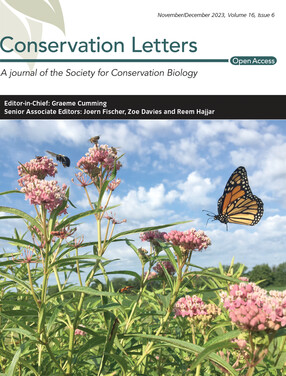利用太阳能减少兼捕海龟
IF 7.7
1区 环境科学与生态学
Q1 BIODIVERSITY CONSERVATION
引用次数: 0
摘要
在过去的十年里,用LED灯或化学荧光棒照亮刺网已经成为一种有希望的解决方案,可以减少海龟的副捕捞,同时保持多个海洋盆地的目标鱼捕捞量。然而,LED灯需要可更换的电池,而化学荧光棒只能持续24小时,这导致渔民的运营成本不断增加,并且担心电池和荧光棒的处理。为了克服这些挑战,我们开发了一种灯,它(1)利用太阳能照亮刺网;(2)针对不同打捞时间下功耗优化的占空比闪烁;(3)被设计成一个浮标,提供了方便的技术集成到现有的渔具。在墨西哥加利福尼亚湾进行的受控渔业实验表明,太阳能照明网在保持目标渔获量的同时,显著降低了预计的平均海龟副渔获率63%。这些结果表明,可以通过利用太阳能来减少渔业副渔获物,这是一种具有全球适用性的新型可再生副渔获物减少技术。本文章由计算机程序翻译,如有差异,请以英文原文为准。
Harnessing Solar Energy to Reduce Sea Turtle Bycatch
Over the past decade, illuminating gillnets with LED lights or chemical lightsticks has emerged as a promising solution to reduce sea turtle bycatch while maintaining target fish catch across multiple ocean basins. However, LED lights require replaceable batteries, and chemical lightsticks only last 24 h, leading to recurring operational costs for fishers and concerns over battery and lightstick disposal. To overcome these challenges, we developed a light that (1) harnesses solar energy to illuminate gillnets; (2) flashes at a duty cycle optimized for power consumption under different fishing durations; and (3) is designed to function as a buoy, providing easy integration of the technology into existing fishing gear. Controlled fishery experiments in Mexico's Gulf of California revealed that solar-powered illuminated nets significantly reduced predicted mean sea turtle bycatch rates by 63% while maintaining target fish catch. These results suggest that fisheries bycatch can be mitigated by harnessing energy from the sun, representing a novel and renewable bycatch reduction technology with potential for global applicability.
求助全文
通过发布文献求助,成功后即可免费获取论文全文。
去求助
来源期刊

Conservation Letters
BIODIVERSITY CONSERVATION-
CiteScore
13.50
自引率
2.40%
发文量
70
审稿时长
>12 weeks
期刊介绍:
Conservation Letters is a reputable scientific journal that is devoted to the publication of both empirical and theoretical research that has important implications for the conservation of biological diversity. The journal warmly invites submissions from various disciplines within the biological and social sciences, with a particular interest in interdisciplinary work. The primary aim is to advance both pragmatic conservation objectives and scientific knowledge. Manuscripts are subject to a rapid communication schedule, therefore they should address current and relevant topics. Research articles should effectively communicate the significance of their findings in relation to conservation policy and practice.
 求助内容:
求助内容: 应助结果提醒方式:
应助结果提醒方式:


